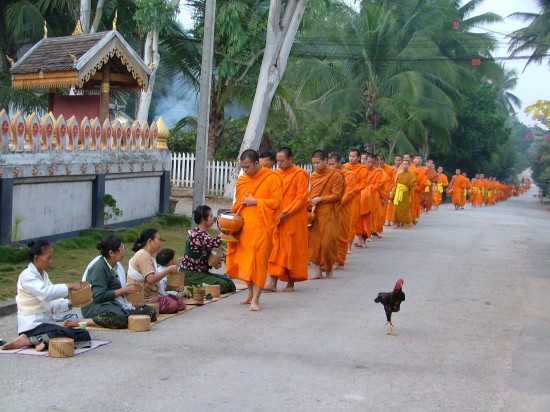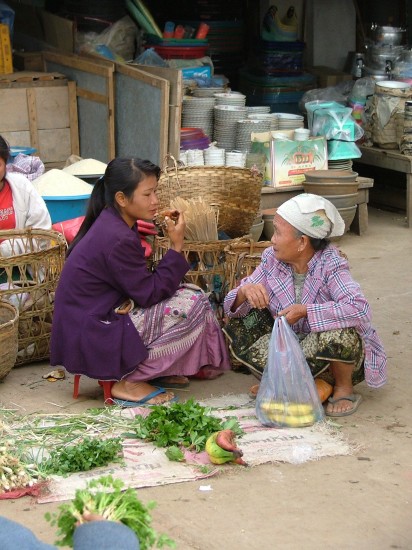In Part 3 of Journey into Laos, Vincent Ross travelled along the Mekong River to Luang Prabang, a place of unearthly beauty. In Part 4, he explores a city where the past overlays the future, and time unfolds gently.
The rhythm of life in Luang Prabang is gentle. The town can easily be explored on foot or, for those with less time, a bicycle can be rented for a couple of dollars a day.
Walking is the best way to go, past faded blue and green or whitewashed French colonial buildings which have been transformed into boutique hotels, with timber-shuttered windows and interiors aglow with polished mahogany staircases, floors and furniture.
Visitors are greeted with a polite, sometimes shy “Sabaidee” (hello) and a smile.
The bicycle and pedicab traffic ebbs and flows past cafes and French-style bakeries, where the food for sale is good, and cheap.
Young monks and novices look at the notice board in front of a monastery, checking their lessons for the day. Nearly all Laotian males will, at some stage of their life, join a monastery, with boys starting as young as eight or nine.
Not only is it a social and religious obligation in this predominantly Buddhist country but it provides the only form of formal education for poor families.
It is a life of prayer, meditation, work and study. The monks and novices live off donated food and shave their heads every full moon.
While the colonial architecture is mostly functional and solid rather than ornate, many of the Buddhist wats, decorated in carvings, lacquer work, gold leaf, gilt paint and intricate, cut-glass mosaics, are stunning.
Up the stairs from the banks of the Mekong, where the royal barge once docked, stands Wat Xieng Thong, probably the most beautiful wat in Luang Prabang. A classic of Laotian architecture, with low, sweeping multi-layered roofs, the temple is exquisite.
Built in the 16th century, it is surrounded by giant bushes of purple, red and orange bougainvillea, frangipani and hibiscus.
The temple walls feature wooden panels of figures from the Ramayana. An elaborate mosaic of coloured glass on a rich red background, a depiction of the bodhi tree, the tree of life, shades proud peacocks with spreading tails, which flash in the afternoon sunshine. Inside, gold-stencilled wooden pillars support a soaring ceiling decorated with dharma wheels.
Around the wat stand a number of impressive chapels, one sheltering a reclining bronze Buddha and another housing a gilded royal funeral wagon.
From the top of Phou Si, surrounded by mountains disappearing into hazy distance, Luang Prabang unfolds under a canopy of palms, broken by the Nam Khan River, which loops around the peninsula to join the Mekong. A hammer taps below among the trees, the only sound of industry in the early morning.
Built in 1804, the golden Phra Thaat spire tops the summit, reached by 328 zigzag stairs up the steep, rocky slope.
The National Museum lies below, the former King’s Palace, a reminder of the city’s royal past. A pavilion in the museum grounds houses Pra Bang, the 83cm-high golden Buddha image from which Luang Prabang takes its name, believed to have been made in the first century AD.
The monarchy ended abruptly in 1975, when the communist Pathet Laotian government came to power. King Sisavangvatthana, Queen Khamphouy and the rest of the Laotian royal family were sent to be “re-educated”, living in cave. They were never heard from again.
The museum on Sisavangvong St, which opened in 1976, is a treasure trove of royal memorabilia. A Throne Room features a breathtaking fresco on a rich burgundy background of early Luang Prabang life, festivals and elephants draped in rich ceremonial capes, created by local artisans from cut glass imported from Japan, framed by ornate, gilt-coated plasterwork under a domed marble ceiling.
A Reception Room is lined with gilt-framed glass cases filled with gifts from other countries, including ivory carvings from India, delicate china from Japan, Nepal and China, lacquerware from Thailand, a gold enamelled tea set from the Soviet Union and a boomerang from Australia.
On display in another room, a tablet inscribed in 1527AD in pali script lists villages that contributed land and money for construction of a new monastery.
In the rear of the museum, pictures of King Sisavangvatthana, Queen Khamphouy and their family hang on the walls — black and white images framed in carved, gilt wood — windows on a tragic past. Stripped of personal trappings except for beds, chests of drawers and wardrobes, the royal sleeping quarters are a shadowy reminder of another time.
Sisavangvong St is closed from 5pm to 10.30pm every day for the Night Markets, where local hill-tribe women sell silverware and handicrafts, including carefully sewn quilt covers and pillow slips and striking woven silk hangings in rich reds, gold, turquoise and jade.
In another time, another royal, the Duchess of Luxembourg, walks freely through the throng of tourist shoppers, followed by a gaggle of minders and photographers. It’s a wry twist of politics and fate.
While the Laotian royal family was “disappeared”, the Duchess is feted, prompted by Luxembourg’s funding of the building of hospitals in the capital, Vientiane.
The next afternoon, two young novice monks in orange robes walk along the path above the Nam Khan River, sheltering from the heat of the sun under a big black umbrella.
The boys whisper among themselves as a lone tourist takes photos as they pass. They stop hesitantly, smile shyly and the younger one holds out his hand, palm up, and scratches it with his index finger, seeking payment for the photo opportunity.
Times change, but hopefully not too quickly in Luang Prabang.
Photo Credits
“Laos: Luang Prabang Buddhist monks collecting alms” © Vincent Ross. All Rights Reserved.
“Laos: Mekong River A Lao Lue boyl in the village of Khon Toune” © Vincent Ross. All Rights Reserved.
“Laos: Luang Prabang market young meets old ” © Vincent Ross. All Rights Reserved.





[…] This post was mentioned on Twitter by christopherholt. christopherholt said: Journey into Laos, Part 4: The Unfolding http://ping.fm/iIkhj […]